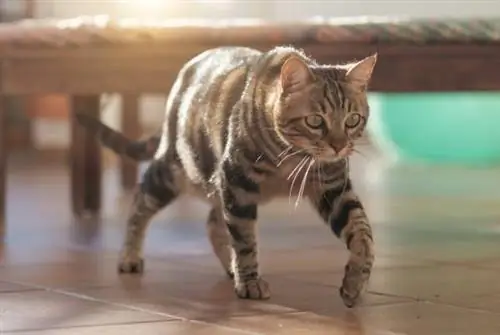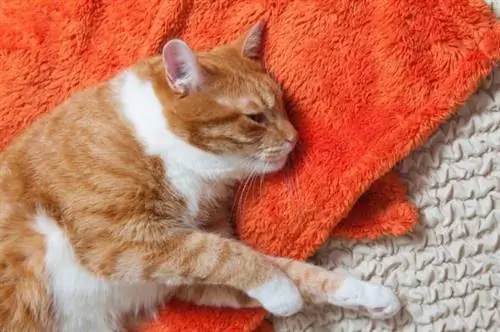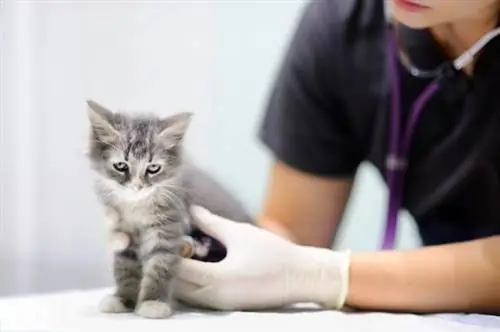- Author Carl Johnson [email protected].
- Public 2023-12-16 06:19.
- Last modified 2025-01-23 08:59.

Cerebellar hypoplasia in cats is mostly due to intrauterine feline panleukopenia virus infection during pregnancy of a cat, passing said virus to the cerebellum of the kittens, where it will cause failures in the growth and development of said organ. Other causes produce cerebellar signs as well, however, cerebellar hypoplasia due to panleukopenia virus is the one that produces the clearest and most specific cerebellar clinical signs, such as hypermetria, ataxia or tremors. These kittens can have a life expectancy and quality similar to that of a cat without this process, although sometimes they can be very serious and will limit it.
In this article on our site we discuss cerebellar hypoplasia in cats, its symptoms and treatment. Keep reading to learn more about this disease that can appear in small felines.
What is cerebellar hypoplasia in cats?
Cerebellar hypoplasia is called the neurological development disorder of the cerebellum, an organ of the central nervous system that is responsible for coordinating movements, harmonize muscle contraction and stop the amplitude and intensity of a movement. This disease is characterized by reduction in the size of the cerebellum with disorganization of its cortex and deficiency of granular and Purkinje neurons.
Due to the function of the cerebellum, cerebellar hypoplasia causes failures in this brake and coordination, leading the feline to present an inability to regulate the amplitude, coordination and force of a movement, which is known like dysmetria.
In cats it may happen that the kittens are born with a cerebellum of reduced size and development that make them show striking clinical signs from their first week of life and that become more and more evident for their caregivers according to they grow.
Causes of cerebellar hypoplasia in cats
Cerebellar damage can be due to congenital or acquired causes after birth at any time in the cat's life, so the causes that can give rise to signs of cerebellar involvement can be:
- Congenital causes: Cerebellar hypoplasia caused by the feline panleukopenia virus is the most frequent, being the only one on the list that He has pure cerebellar signs. Other genetic causes include congenital hypomyelinogenesis-desmyelinogenesis, although it can also be caused by viruses or be idiopathic with no apparent origin and cause tremors throughout the cat's body. Other causes are cerebellar abiotrophy, which is very rare and can also be caused by the feline panleukopenia virus, leukodystrophies and lipodystrophies, or gangliosidosis.
- Acquired causes: inflammations such as granulomatous encephalitis (toxoplasmosis and cryptococcosis), feline infectious peritonitis, parasites such as Cuterebra and feline rabies. They may also be due to diffuse degeneration caused by plant or fungal toxins, organophosphates, or heavy metals. Other causes would be trauma, neoplasms and vascular alterations such as heart attacks or hemorrhages.
However, the most common cause of cerebellar hypoplasia in kittens is contact with feline panleukopenia virus (feline parvovirus) either by infection of the cat during pregnancy or when a pregnant cat is vaccinated with a modified live feline panleukopenia virus vaccine. In both forms, the intrauterine virus reaches the kittens and causes damage to their cerebellum. The damage of the virus in the cerebellum is fundamentally directed towards the outer germinal layer of said organ, which will give rise to the definitive layers of the cortex of the fully developed cerebellum, so that by destroying these forming cells, the growth and development of the cerebellum is seen. highly committed.
Symptoms of cerebellar hypoplasia in cats
Clinical signs of cerebellar hypoplasia become evident when the kitten begins to walk, being the following:
- Hypermetry (walking with legs apart with wide and sudden movements).
- Ataxia (incoordination of movements).
- Tremors, especially in the head, that get worse when they start eating.
- They jump exaggeratedly, with little precision.
- Tremors at the beginning of the movement (of intention) that disappear at rest.
- Posture evaluation response first delayed and then exaggerated.
- Rolling trunk when walking.
- Awkward, jerky, and sudden limb movements.
- Oscillatory or pendulum fine eye movements.
- When resting, it extends all four legs.
- Deficiency in bilateral threat response may appear.
Some cases are very mild while in others the dysfunction is so severe that they present difficulty eating and walking.

Diagnosis of cerebellar hypoplasia in cats
The definitive diagnosis of feline cerebellar hypoplasia is made by the laboratory or imaging tests, but generally the very obvious symptomatology of cerebellar disorder in a weeks-old kitten is usually enough to make the diagnosis of this illness.
Clinical Diagnosis
When faced with a baby cat with uncoordinated gait, exaggerated gait, wide-based posture with outstretched legs, or tremors that are exaggerated when approaches the food bowl and stop when the cat rests, the first thing to think about is hypoplasia of the cerebellum due to feline panleukopenia virus.
Lab Diagnosis
Laboratory diagnosis will always confirm the disease by means of a histopathology examination after taking a sample of the cerebellum and detecting hypoplasia.
Diagnostic imaging
Imaging tests are the best diagnostic method for cerebellar hypoplasia in cats, specifically the use of a MRI or the computed tomography will show the cerebellar changes indicative of this process.

Treatment of cerebellar hypoplasia in cats
Cerebellar hypoplasia in cats There is no cure or treatment, but it is not a progressive disease, which means that the kitten is not going to get worse as it grows and, although it will never move like a normal cat, it can have the quality of life that a cat without cerebellar hypoplasia has, so it should not be an impediment when it comes to being adopted and much least one reason for euthanasia if the cat is fine despite its incoordination and tremors. You can try neurological rehabilitation through proprioception and balance exercises or active kinesitherapy. The cat is learning to live with what he has been given, compensating for his limitations and avoiding jumps that are difficult, too high or that require absolute coordination of movements
The life expectancy of a cat with hypoplasia can be exactly the same as for a cat without it, always lower if it is a street cat, in which this disease is usually more frequent, since street cats are more likely to contract the virus when pregnant and, in general, all cats are at greater risk of suffering from nutritional deficiencies, poisoning and other infections that would also cause disorders in the cerebellum. A street cat with cerebellar hypoplasia has it much more difficult, as no one can help him with his movements or his ability to jump, climb and even hunt.
It is very important the vaccination of cats. If we vaccinate cats against panleukopenia, this disease in their offspring can be avoided, as well as the systemic disease of panleukopenia in all cats.






